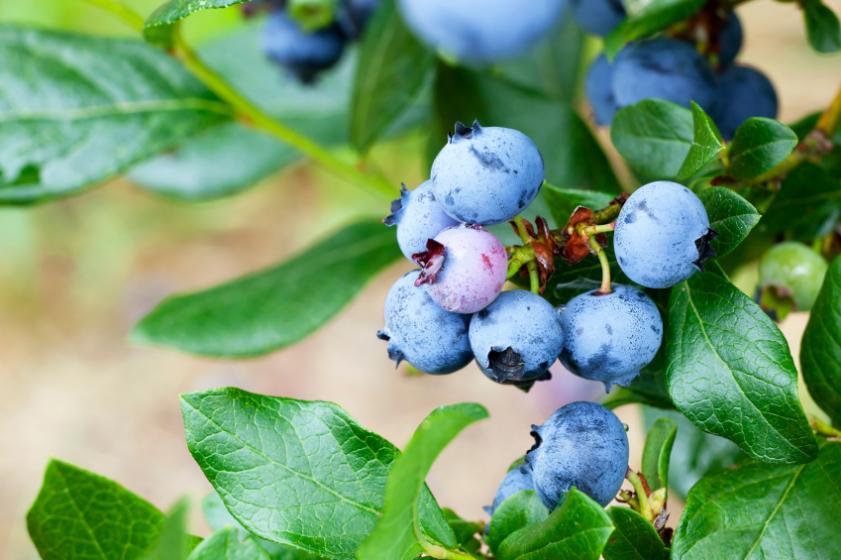By Eddie Anderson, Owner
Thinking about growing backyard blueberries? Stick to these six simple tips and with proper care, these sweet treats will reward you for years to come!
- Test the soil and adjust to a pH 4.5 – 5.5
- Mix peat moss in the soil around the plants
- Plant 2 or more varieties in the same class
- Cover the soil with 4” of mulch
- As berries ripen use bird net to protect the crop
- Once mature remove old canes.
Test the soil and adjust to a pH 4.5 – 5.5
When the pH is above five, the blueberry plants become stunted and do not become vigorous enough to set good crops of berries. McDonald offers 2 solutions for acidifying the soil. Soil Sulfur is the best for long term adjustment of pH. Soil acidifier is good for quick adjustment of soil pH, however, it may cause aluminum toxicity in blueberries. (http://blueberries.msu.edu/uploads/files/Lowering_Soil_pH_with_Sulfur.pdf)
Sulfur must be applied in the spring or summer, since it requires bacterial activity to convert the sulfur to an active form. Soil acidifier is water soluble and thus works more quickly. McDonald Garden Center offers soil test kits for home garden use, and Garden Rewards members can get free pH soil test at any of our locations.
Mix peat moss in the soil around the plants
Peat moss is an excellent source of organic matter. It helps loosen clay soil for development of the very fibrous roots of blueberries. Peat moss helps sandy soils retain moisture and improves soil nutrient capacity. At the same time, it is a natural soil acidifier. Old leaf mold, old sawdust, lime free compost and bark fines are other sources of organic matter that can be used. Any compost that has had lime used in the composting process (Magill Compost as well as most composted cow manure products is an example) will have a negative effect as a soil amendment and should not be used.
Plant two or more varieties
Research has shown that yields of fruit are up to 25% higher with good cross pollination among varieties of the same species of blueberries. There are several species of Blueberries (Vaccinium) that produce good, edible fruit. The species we deal in are:
Vaccinium virgatum (rabbiteye blueberry; syn. V. ashei)
Vaccinium corymbosum (northern highbush blueberry)
Vaccinium angustifolium (lowbush blueberry)
The pollen from one species generally does not ripen at the same time or is not compatible with another species. Therefore you must use two varieties from the same species to get the benefit of increased yields. Plant breeders have found ways to cross species. These crosses produce large fruit on compact plants that make them easy to protect from birds.
Cover the soil with 4-inches of mulch
Research by the leading universities in zone 5-8 have shown that yields of blueberries will increase up to 30% when the soil has 4-inches of mulch cover. The roots of blueberries, like other ericaceous plants like azaleas, rhododendron and heathers, are very fine and fibrous. The mulch helps hold the moisture around the roots. It helps keep the soil cooler during the summer and warmer in the winter. In addition, bark mulches add organic matter as they decay and tend to acidify the soil. Be sure that the mulch does not develop a crust layer on the surface that sheds water. Fruit size is diminished when the roots dry out during periods of drought.
As berries ripen, use a bird net to protect the crop
It may not happen in the first few years of production, but eventually the birds will learn just how good those little blueberries are. I have had excellent success with a bird net cover. It is necessary to have a frame to keep the net off of the plants. The berries easily get caught in the net and pop off.
Once mature, remove old canes.
As the canes mature the productivity declines. Removing these canes stimulates the production of new ones from the root of the plant. This keeps the plant in the juvenile stage and extents the life of the plant. The young canes are much more productive. Remove about 1/3 of the volume of the plant during the winter each year on healthy plants.
Be sure to visit any McDonald Garden Center or Garden Market this Memorial Day weekend, for Flavor Fest, May 24-29, 2017, for juicy deals on all things edibles.

